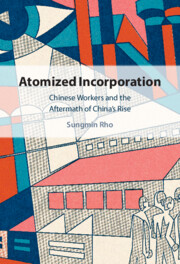25 results
The 2022 protests in Karakalpakstan. From lost autonomy to regional identity consolidation?
-
- Journal:
- Nationalities Papers , FirstView
- Published online by Cambridge University Press:
- 10 February 2025, pp. 1-20
-
- Article
-
- You have access
- Open access
- HTML
- Export citation
17 - Nonprofits as Sources of Authoritarian Regime Stability
- from Part III - New Directions
-
-
- Book:
- Reimagining Nonprofits
- Published online:
- 11 January 2024
- Print publication:
- 01 February 2024, pp 333-352
-
- Chapter
- Export citation
6 - Interest-Based Collective Action and Firm-Level Patterns of Labor Protests
-
- Book:
- Atomized Incorporation
- Published online:
- 17 June 2023
- Print publication:
- 17 August 2023, pp 161-185
-
- Chapter
- Export citation
1 - Introduction
-
- Book:
- Atomized Incorporation
- Published online:
- 17 June 2023
- Print publication:
- 17 August 2023, pp 1-23
-
- Chapter
- Export citation
2 - The Political Costs of Labor Coercion: The Changing Socioeconomic Environment since the 2000s
-
- Book:
- Atomized Incorporation
- Published online:
- 17 June 2023
- Print publication:
- 17 August 2023, pp 24-45
-
- Chapter
- Export citation

Atomized Incorporation
- Chinese Workers and the Aftermath of China's Rise
-
- Published online:
- 17 June 2023
- Print publication:
- 17 August 2023
BHR Agenda and Authoritarian Regimes: The Case of Political and Human Rights Crisis in Belarus Since 2020
-
- Journal:
- Business and Human Rights Journal / Volume 9 / Issue 1 / February 2024
- Published online by Cambridge University Press:
- 20 April 2023, pp. 150-156
-
- Article
-
- You have access
- Open access
- HTML
- Export citation
State Mobilization in Authoritarian Regimes: Youth Politics and Regime Legitimation in Cambodia
-
- Journal:
- Journal of East Asian Studies / Volume 22 / Issue 3 / November 2022
- Published online by Cambridge University Press:
- 24 October 2022, pp. 411-434
-
- Article
- Export citation
5 - Guiding Cases as a Form of Statutory Interpretation
-
- Book:
- Law as an Instrument
- Published online:
- 07 July 2022
- Print publication:
- 21 July 2022, pp 109-136
-
- Chapter
- Export citation
3 - Judicial Interpretation as a de facto Primary Statute for Adjudication
-
- Book:
- Law as an Instrument
- Published online:
- 07 July 2022
- Print publication:
- 21 July 2022, pp 60-81
-
- Chapter
- Export citation
4 - The Judicial Document as Informal State Law
-
- Book:
- Law as an Instrument
- Published online:
- 07 July 2022
- Print publication:
- 21 July 2022, pp 82-108
-
- Chapter
- Export citation
7 - Concluding Reflections
-
- Book:
- Law as an Instrument
- Published online:
- 07 July 2022
- Print publication:
- 21 July 2022, pp 162-180
-
- Chapter
- Export citation
6 - Bureaucratization of Judicial Precedents
-
- Book:
- Law as an Instrument
- Published online:
- 07 July 2022
- Print publication:
- 21 July 2022, pp 137-161
-
- Chapter
- Export citation
1 - Introduction
-
- Book:
- Law as an Instrument
- Published online:
- 07 July 2022
- Print publication:
- 21 July 2022, pp 1-15
-
- Chapter
- Export citation
9 - “Normal” Parties in Extraordinary Times: The Case of Primero Justicia and Voluntad Popular in Venezuela
-
-
- Book:
- Diminished Parties
- Published online:
- 09 December 2021
- Print publication:
- 16 December 2021, pp 173-196
-
- Chapter
- Export citation
THE LONG-TERM EFFECTS OF STATE REPRESSION ON POLITICAL BEHAVIOR AND ATTITUDES: EVIDENCE FROM TAIWAN
-
- Journal:
- Journal of East Asian Studies / Volume 21 / Issue 3 / November 2021
- Published online by Cambridge University Press:
- 02 November 2021, pp. 427-448
-
- Article
- Export citation
8 - Economic Crises in Latin America and East Asia
-
- Book:
- A History of Big Recessions in the Long Twentieth Century
- Published online:
- 06 February 2020
- Print publication:
- 20 February 2020, pp 160-192
-
- Chapter
- Export citation
Maintaining Social Stability without Solving Problems: Emotional Repression in the Chinese Petition System
-
- Journal:
- The China Quarterly / Volume 243 / September 2020
- Published online by Cambridge University Press:
- 17 December 2019, pp. 635-654
- Print publication:
- September 2020
-
- Article
- Export citation
Ruling Parties in Authoritarian Regimes: Rethinking Institutional Strength
-
- Journal:
- British Journal of Political Science / Volume 51 / Issue 2 / April 2021
- Published online by Cambridge University Press:
- 25 September 2019, pp. 526-540
-
- Article
- Export citation
Autocratic time horizons and the growth effect of foreign direct investment
-
- Journal:
- Japanese Journal of Political Science / Volume 20 / Issue 3 / September 2019
- Published online by Cambridge University Press:
- 22 May 2019, pp. 143-161
-
- Article
- Export citation

